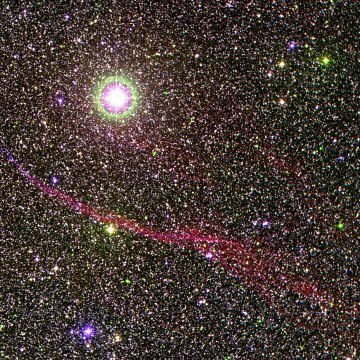Sh 2-91
Coordinates: (64.06°, 4.42°)
[ Catalog | Explorer | SIMBAD ]
Avedisova places Sh 2-91 in the star formation region SFR 64.06+4.42, along with the Footprint nebula.
The image here shows only a small section of this nebula. You can view a larger and more detailed image of this nebula here.
This is part of the supernova remnant G65.2 +5.7[2]
A Russian paper from 2010 concludes that several supernova explosions may have occurred in this region. [3]
The full extent of the supernova remnant can be seen in the visual frequency images in a 2004 paper. [4]
Notes
1. ^ Mavromatakis, F., Boumis, P., Papamastorakis, J., et al. (2002). "Deep optical observations of G 65.3+5.7", Astronomy and Astrophysics, Vol. 388, 355-362. [2002A&A...388..355M]
2. ^ Reich, W., Berkhuijsen, E. M., & Sofue, Y. (1979). "Radio continuum observations at 1420 MHz of the new SNR G65.2+5.7 in Cygnus", Astronomy and Astrophysics, Vol. 72, 270-276. [1979A&A....72..270R]
3. ^ Gosachinskii, I. V. (2010). "Association of the supernova remnant G 65.3+5.7 with ambient neutral hydrogen and a possible nature of the remnant", Astronomy Letters, Vol. 36, 260-268. [2010AstL...36..260G]
4. ^ Boumis, P., Meaburn, J., López, J. A., et al. (2004). "The kinematics of the bi-lobal supernova remnant G 65.3+5.7. II..", Astronomy and Astrophysics, Vol. 424, 583-588. [2004A&A...424..583B]
Links
[ DSS | ADS | ADS Abstract ]
map | book | blog | gallery | sources

This image was created using the POSS-II/UKSTU data of the Digitized Sky Survey and SuperCOSMOS using the process described here.
According to my correspondence with the Royal Observatory Edinburgh and the Space Telescope Science Institute, I am allowed to use the POSS-II/UKSTU data to create and display images for non-commercial purposes so long as I include this fine print for the SuperCOSMOS data:
Use of these images is courtesy of the UK Schmidt Telescope (copyright in which is owned by the Particle Physics and Astronomy Research Council of the UK and the Anglo-Australian Telescope Board) and the Southern Sky Survey as created by the SuperCOSMOS measuring machine and are reproduced here with permission from the Royal Observatory Edinburgh.
and this acknowledgement taken from the DSS site:
The Digitized Sky Surveys were produced at the Space Telescope Science Institute under U.S. Government grant NAG W-2166. The images of these surveys are based on photographic data obtained using the Oschin Schmidt Telescope on Palomar Mountain and the UK Schmidt Telescope. The plates were processed into the present compressed digital form with the permission of these institutions.
The Second Palomar Observatory Sky Survey (POSS-II) was made by the California Institute of Technology with funds from the National Science Foundation, the National Geographic Society, the Sloan Foundation, the Samuel Oschin Foundation, and the Eastman Kodak Corporation.
The UK Schmidt Telescope was operated by the Royal Observatory Edinburgh, with funding from the UK Science and Engineering Research Council (later the UK Particle Physics and Astronomy Research Council), until 1988 June, and thereafter by the Anglo-Australian Observatory. The blue plates of the southern Sky Atlas and its Equatorial Extension (together known as the SERC-J), as well as the Equatorial Red (ER), and the Second Epoch [red] Survey (SES) were all taken with the UK Schmidt.
The "Second Epoch Survey" of the southern sky was made by the Anglo-Australian Observatory (AAO) with the UK Schmidt Telescope. Plates from this survey have been digitized and compressed by the ST ScI. The digitized images are copyright ? 1993-5 by the Anglo-Australian Observatory Board, and are distributed herein by agreement.
The "Equatorial Red Atlas" of the southern sky was made with the UK Schmidt Telescope. Plates from this survey have been digitized and compressed by the ST ScI. The digitized images are copyright ? 1992-5, jointly by the UK SERC/PPARC (Particle Physics and Astronomy Research Council, formerly Science and Engineering Research Council) and the Anglo-Australian Telescope Board, and are distributed herein by agreement.
The compressed files of the "Palomar Observatory - Space Telescope Science Institute Digital Sky Survey" of the northern sky, based on scans of the Second Palomar Sky Survey are copyright ? 1993-1995 by the California Institute of Technology and are distributed herein by agreement. The compressed files of the "Palomar Observatory - Space Telescope Science Institute Digital Sky Survey" of the northern sky, based on scans of the Second Palomar Sky Survey are copyright ? 1993-1995 by the California Institute of Technology and are distributed herein by agreement.